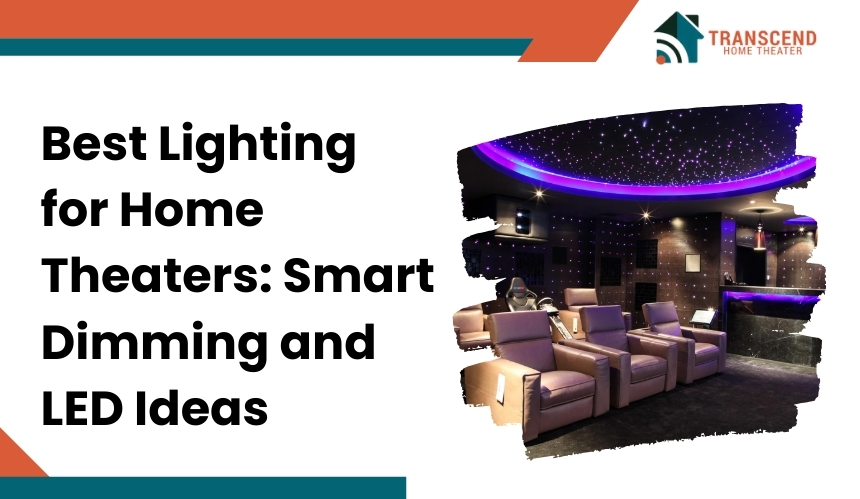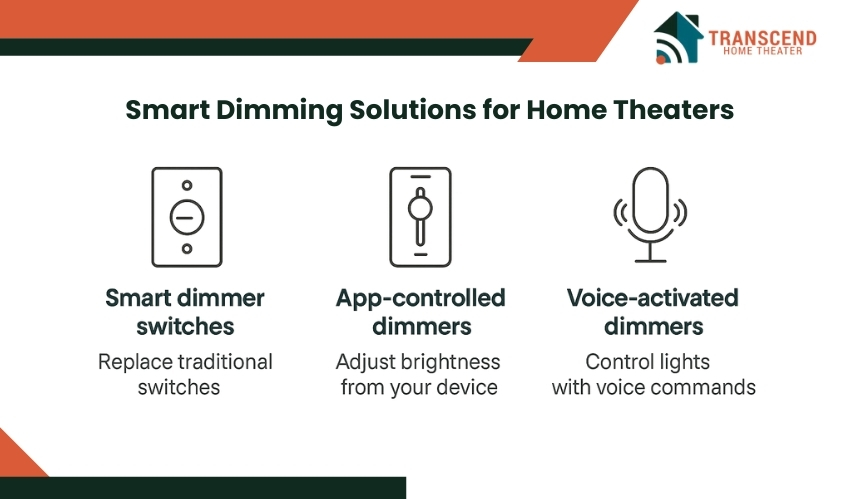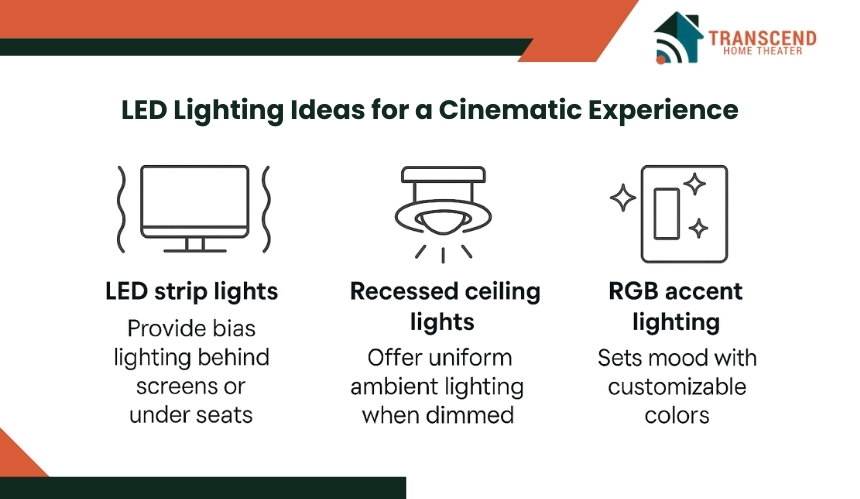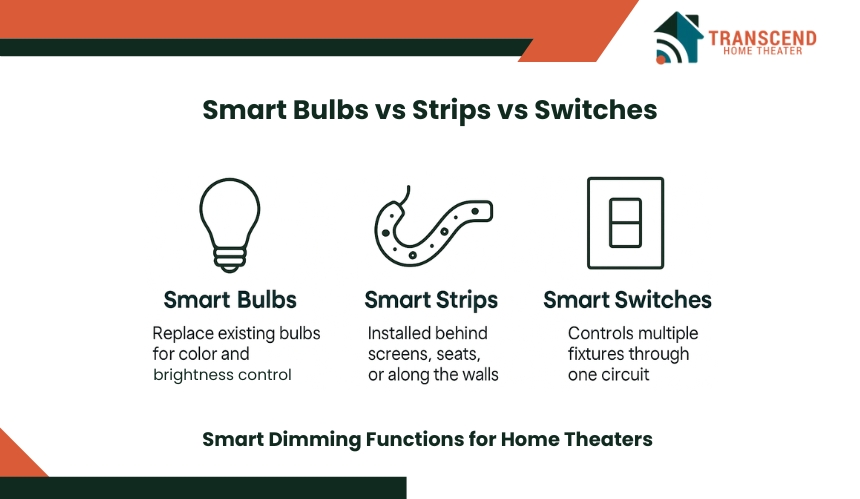Best Lighting for Home Theaters: Smart Dimming and LED Ideas

Lighting is one of the most overlooked elements in home theater design, yet it directly affects immersion, comfort, and visual clarity. With the rise of smart dimming systems and advanced LED lighting, homeowners now have precise control over brightness, color temperature, and ambiance.
This blog will cover the best lighting options for home theaters, including smart dimming solutions, LED strip ideas, recessed lighting, and accent designs that enhance both style and performance.
Understanding Home Theater Lighting Needs

A home theater requires more than just a dark room. The right balance of lighting ensures comfort without sacrificing picture quality. Lighting design should focus on three main layers:
- Ambient lighting: Provides overall illumination without creating glare on the screen. Recessed ceiling lights or dimmable fixtures are most effective.
- Task lighting: Supports practical needs like reading controls, handling snacks, or moving safely without disturbing the viewing experience. Wall sconces or step lights are common choices.
- Accent lighting: Adds atmosphere by highlighting architectural features, behind-screen glow, or LED strips under seating.
Poor lighting can wash out images, cause reflections, or make long sessions uncomfortable. Factors such as room size, screen type, seating position, and wall color influence the best approach. Projector-based theaters typically need more controlled low-level lighting, while TV-based setups allow slightly more flexibility.
Smart Lighting Ideas for Home Theaters

Smart lighting transforms a home theater into an adaptive space where every scene feels intentional. Unlike standard switches, smart systems allow precise control of brightness, color, and timing through apps, remotes, or voice assistants. The following smart lighting ideas show how to combine control, convenience, and ambiance in a home theater:
- Smart LED strips with voice control: Place strips under seats, behind screens, or along walls to change color and brightness without interrupting the movie. They create subtle glow zones that improve contrast and add depth to the room.
- Automated step lights: Program low-level pathway lights to turn on automatically when someone enters or leaves the room. This ensures safe movement without disrupting the viewing experience.
- Recessed smart downlights: Use app-based control to gradually dim ceiling lights as the movie starts, simulating the cinema effect. Their flush design also keeps the focus on the screen rather than the fixtures.
- Motion-sensor accent lighting: Install sensors so accent LEDs switch on when movement is detected, useful during breaks without needing manual control. This provides both convenience and energy efficiency.
- Color-sync modes: Sync lighting with movie scenes or gaming action for an immersive feel. Changing hues create dynamic atmosphere shifts that enhance the overall cinematic mood.
What are the Key Advantages of Smart Lighting?
- Scene presets: Instantly shift from a bright setting for setup to a dim, cinematic mode when the movie starts.
- Voice and app integration: Control lights hands-free with Alexa, Google Home, or Apple HomeKit.
- Automation: Schedule dimming or color changes that sync with your viewing routine.
- Energy savings: Smart LEDs consume less power while lasting longer than traditional bulbs.
Smart Dimming Solutions for Home Theaters

Dimming is essential in a home theater because it allows you to fine-tune brightness for comfort and immersion. The right dimming setup reduces glare, enhances contrast, and keeps focus on the screen while maintaining enough light for safety.
What are the Types of Smart Dimming Solutions?
Dimming technology comes in several forms, each offering a different level of control and convenience. Three of the most common types are described below:
- Smart dimmer switches: Replace traditional wall switches and provide room-wide control through physical buttons or connected apps.
- App-controlled dimmers: Adjust brightness directly from a smartphone or tablet without leaving your seat.
- Voice-activated dimmers: Use Alexa, Google Assistant, or Siri to instantly set the perfect light level with a simple command.
What are the Practical Uses of Smart Dimming?
Smart dimming is most effective when used with purpose. Here are the main scenarios where it improves the home theater experience.
- Pre-movie: Lights dim gradually to set the mood.
- During the movie: Maintain low ambient lighting that prevents total darkness but does not interfere with picture quality.
- After the movie: Lights restore automatically for safe movement and cleanup.
Smart dimming gives homeowners theater-level control with convenience, making it one of the most impactful upgrades for any home cinema.
LED Lighting Ideas for a Cinematic Experience

LED technology offers flexible design options and precise control over brightness and color. The following LED ideas create an atmosphere that balances function with cinematic style.
How Can LED Strip Lights Enhance a Home Theater?
LED strips placed behind the screen or under seating create a soft backlight known as bias lighting. This reduces eye strain, improves perceived contrast, and gives the screen a floating effect. Under-seat strips add subtle guidance for safe movement during dark scenes.
Why Use Recessed LED Ceiling Lights?
Recessed LEDs deliver uniform ambient lighting without drawing attention away from the screen. When paired with smart dimmers, they allow gradual adjustment from bright to low-level glow, making them ideal for multipurpose theater rooms.
What Makes RGB LED Accent Lighting Effective?
RGB strips or panels allow color customization to match the mood of the movie. Warm tones enhance cozy atmospheres, while cooler tones suit action or sci-fi films. Controlled by apps or voice commands, they adapt instantly to different viewing preferences.
How Do Fiber Optic Star Ceilings Create a Cinematic Atmosphere?
Fiber optic LEDs recreate the look of a night sky, turning the ceiling into a visual centerpiece. This design not only adds luxury but also creates a calming effect, making the theater space feel immersive even before the movie begins.
Are Wall Sconces and Backlit Panels Still Used?
Yes. Wall-mounted LED sconces and backlit panels provide accent lighting that complements the room’s theme. They deliver theater-like ambiance while ensuring pathways remain safely lit.
Comparing Smart Bulbs vs. Smart LED Strips vs. Smart Switches

Choosing the right smart lighting product depends on budget, flexibility, and installation needs. Each option has unique advantages and limitations that influence the final theater setup.
How Do Smart Bulbs Perform in a Home Theater?
Smart bulbs are the simplest upgrade because they fit into existing fixtures. They allow color and brightness control through apps or voice assistants. However, they work best in lamps or ceiling fixtures rather than specialized theater lighting, and multiple bulbs may need syncing for consistent results.
What Are the Benefits of Smart LED Strips?
LED strips provide versatile placement options, from behind the TV to under seats and along walls. They deliver bias lighting, accent effects, and RGB customization. Strips are cost-effective and energy efficient, though proper installation and power management are essential for a uniform glow.
Why Consider Smart Switches Instead of Bulbs or Strips?
Smart switches control entire circuits, making them ideal for recessed ceiling lights or multiple sconces. They integrate seamlessly with existing fixtures while offering dimming, scheduling, and voice control. The main limitation is installation, as they typically require wiring adjustments.
Practical Tips for Choosing the Right Home Theater Lighting Setup
The best lighting setup combines functionality, comfort, and efficiency. Homeowners should weigh budget, room design, and compatibility before making final decisions.
What Lighting Options Work Best on a Budget?
For cost-conscious setups, smart LED strips and dimmable bulbs offer a noticeable impact at low cost. They provide accent glow, customizable colors, and app-based control without requiring complex installation.
How Does Energy Efficiency Affect Lighting Choices?
LEDs consume less power and last significantly longer than traditional bulbs. Choosing energy-efficient products lowers long-term operating costs and reduces heat buildup, which is especially important in enclosed theater rooms.
What Should Be Considered During Installation?
Check wiring compatibility before installing smart switches or dimmers. Avoid mixing incompatible LEDs with older dimmers to prevent flicker. For strips and accent lighting, ensure adequate power supply and safe cable management.
Why Is Safety Important in a Home Theater?
Low-level pathway lighting prevents accidents without interrupting the viewing experience. Step lights, under-seat strips, and wall sconces ensure safe movement during or after a movie, especially in darker dedicated rooms.
Frequently Asked Questions (FAQs)
Yes. Many smart LED systems include synchronization features that match lighting effects with on-screen action or soundtracks. This creates a dynamic, immersive experience often seen in gaming setups and high-end theaters.
Modern wireless lighting systems using Wi-Fi or Zigbee are stable and responsive. They eliminate the need for extensive wiring, making them ideal for retrofitting living rooms into theater spaces. With mesh networking, performance improves even in larger rooms.
Basic setups like LED strips and smart bulbs can be installed by homeowners. However, complex systems involving smart switches, recessed lights, or integrated automation benefit from professional installation to ensure safety and compatibility. A professional can also help optimize placement for the best visual effect.
Warm white (around 2700K–3000K) creates a cozy, cinema-like feel, while neutral white (around 4000K) works better for multipurpose rooms. RGB lighting offers flexibility for mood-based customization. Adjustable white LEDs are ideal if you want one fixture for both casual use and immersive viewing.
